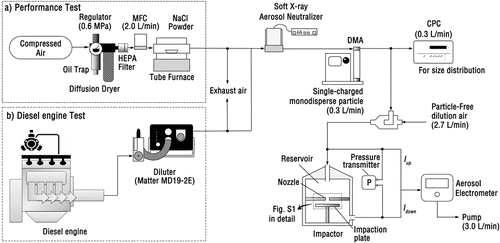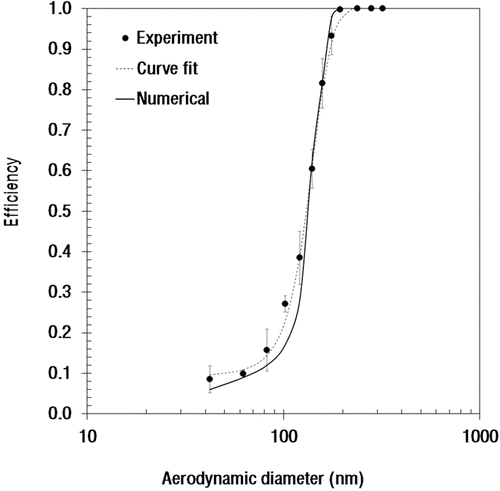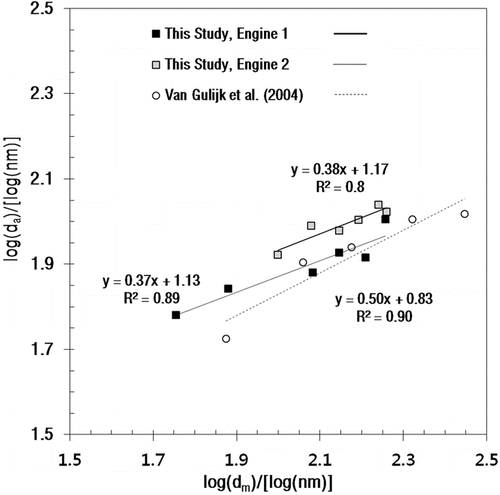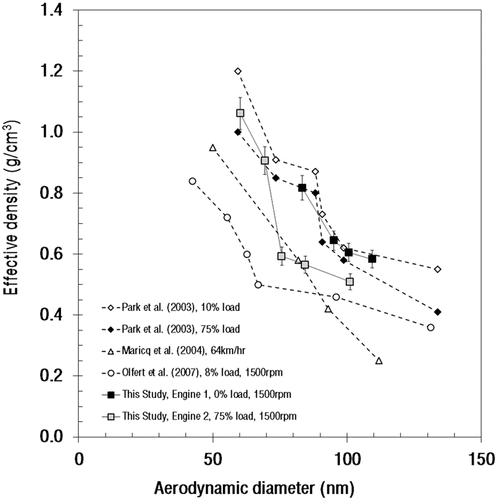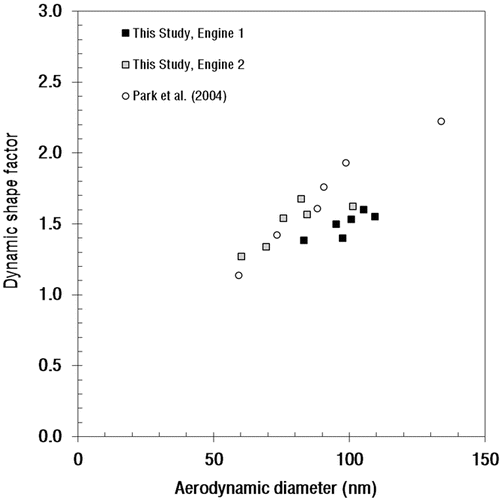Abstract
A serial method is described for estimating the particle effective density and dynamic shape factor of particles, i.e., diesel exhaust particles (DEPs). For this purpose, we designed a single stage low-pressure impactor with a cutoff diameter of 130 nm. The collection efficiency curve of the impactor was obtained using mobility-classified sodium chloride (NaCl) particles as a function of the mobility diameter. Then by converting the mobility diameter of the NaCl particle into the aerodynamic equivalent diameter, the efficiency curve can be expressed as a function of the aerodynamic diameter. We also obtained the efficiency curve numerically by using a commercial computational fluid dynamics software package. After confirming the design and performance of the impactor (experimentally 135 nm and numerically 137 nm of cutoff diameter), we measured the currents carried by mobility-classified DEPs downstream and upstream of the impactor so that the collection efficiency value for DEP could be obtained at each mobility diameter of DEPs. By making this value equal to that of the efficiency curve, the relationship between the mobility diameter of DEPs and the aerodynamic diameter was obtained; this enabled us to determine the effective density and dynamic shape factor of DEPs. The effective density decreased from 1.06 to 0.51 g/cm3 and the dynamic shape factor increased from 1.28 to 1.64 as the particle size increased from 60 to 105 nm, regardless of the engine type or operating conditions.
Copyright 2015 American Association for Aerosol Research
1. INTRODUCTION
Particulate emissions from diesel vehicles are a major source of ultrafine particles in the atmosphere. The size distribution of diesel exhaust particles (DEPs) differs for different engines and operation conditions, but the typical mean mobility diameter of DEPs is 50–100 nm (Burtscher Citation2005; Kittelson et al. Citation2006; Asbach et al. Citation2009). DEPs are chain-shaped agglomerates, similar to other combustion-generated particles. The structure of particles is directly related to their transport properties and plays an important role in determining their deposition pattern in the human respiratory system. Particles can be characterized by many different properties such as their number concentration, mass concentration, particle size, density, dynamic shape factor, etc. The effect of an irregular shape on the drag force of a particle is expressed as the dynamic shape factor. It is defined as the ratio of the actual resistance force of the nonspherical particle to the resistance force of a sphere having the same volume and velocity as the nonspherical particle (Hinds Citation1999). Particle density is also an important property for aerosol particles. For example, knowing the particle density is required to determine the relationship between the Stokes and aerodynamic diameters and to convert the measured number concentration into the mass concentration, which is used in governmental regulation. The particle effective density is a parameter that describes the combined effects of the particle density and shape upon aerosol motion.
To measure the particle effective density, it is typical to use two instruments connected in series. Kelly and McMurry Citation(1992) introduced the basic approach used in this methods and utilized this technique to analyze lab-generated particles. They used a differential mobility analyzer (DMA) and a microorifice uniform deposit impactor (MOUDI) with known cutoff diameters. Additionally, McMurry et al. Citation(2002) and Park et al. Citation(2003) measured the effective density of atmospheric aerosols and DEPs, respectively; they classified particles with a DMA and then measured the particle mass with an aerosol particle mass analyzer (APM). For each APM voltage, the particle number concentration was measured with a condensation nucleus counter, and the peak APM voltage, which corresponds to the peak mass for the mobility-selected particles, was determined. The particle effective density was obtained by carrying out sequential measurements on atmospheric aerosols (or diesel particles) and polystyrene spheres of the same mobility size. Olfert et al. Citation(2007) used a Couette centrifugal particle mass analyzer (CPMA), which is similar to the APM but with an improved transfer function, to measure the effective density of particles emitted from a light-duty diesel vehicle. Malloy et al. Citation(2009) used an APM and a scanning mobility particle sizer (SMPS) for the density analysis of secondary organic aerosol density evolution.
In the studies mentioned above, the effective density was determined by the particle mass that was measured. However, the effective density can also be calculated once the particle mobility diameter and the aerodynamic diameter have been determined. An electrical low-pressure impactor (ELPI), which measures the aerodynamic particle diameter, can also be used (instead of APM or CPMA). Thus, Virtanen et al. Citation(2002) used a DMA and an ELPI in experiments using three different engine speeds and two types of diesel fuel with different sulfur contents. Maricq and Xu Citation(2004) studied the effective density of diesel particles by using both a DMA and an ELPI. They classified particles with a DMA and then measured the aerodynamic size of the classified particles with an ELPI. Van Gulijk et al. Citation(2004) also used a DMA and an ELPI and verified that the estimated mobility diameter based on the aerodynamic diameter gave a better indication of the apparent particle size compared to the results of aerodynamic particle size analysis based on scanning electron microscopy (SEM). In addition, Tavakoli and Olfert Citation(2014) classified the aerodynamic diameter using an aerodynamic aerosol classifier and then measured the mobility diameter of the classified particles with a DMA. The effective density was obtained with the mobility diameter and the corresponding aerodynamic diameter.
In the present work, a single-stage impactor was designed and fabricated based on classical impactor design theory. For performance evaluation, the collection efficiency curve of the impactor was obtained using mobility-classified sodium chloride (NaCl) particles as a function of their mobility diameter. Then by converting the mobility diameter of NaCl particles into the aerodynamic equivalent diameter with the known dynamic shape factor and particle density of NaCl particles of 1.08 and 2.165 g/cm3, respectively, the efficiency curve was transformed as a function of the aerodynamic diameter. Afterward, the currents carried by the mobility-classified DEPs downstream and upstream of the impactor were measured, and the collection efficiency value for DEPs was calculated at each mobility diameter. Hence, the relationship between the mobility diameter of DEPs and the aerodynamic diameter could be obtained, enabling the determination of the effective density and dynamic shape factor of DEPs.
In addition to evaluating the performance of impactors experimentally, numerical methods have also been used; these allow parameters to be changed more easily. Thus, Huang and Tsai (2001) investigated the effect of gravity upon the particle collection efficiency of a single round-nozzle inertial impactor. They also investigated the influence of the impaction plate diameter and particle density upon the particle collection efficiency (Huang and Tsai Citation2002). Gulak et al. Citation(2009) used a single jet model to analyze the performance of an Andersen cascade impactor by using ANSYS FLUENT, which is a commercial computational fluid dynamics software package, and compared the results to experimental data obtained by Vaughan Citation(1989), Nichols et al. Citation(1998), Srichana et al. Citation(1998) and Zhou et al. Citation(2007). Regarding low-pressure impactor performance, Leduc et al. Citation(2006) studied an ELPI with laminar and different kinds of turbulent models by using ANSYS FLUENT; however, their simulations were not accurate for nanoparticles. They insisted that simulations are not accurate for flow velocities above 50 m/s. Arffman et al. Citation(2011) also studied low-pressure ELPI stages based on time-averaged flow field simulation with ANSYS FLUENT and used Matlab for particle trajectories. They concluded that equations based on the time-averaged Navier–Stokes equations could not be used, and that the effect of turbulent dispersion must be taken into account if the local Reynolds number exceeds 1800.
In this article, we designed a single stage low-pressure impactor and carried out performance tests with NaCl particles. Numerical calculations were also conducted to predict the performance of our impactor. Then, we applied a serial method to estimate the effective density and dynamic shape factor of DEP emitted from two different engines.
2. EFFECTIVE DENSITY AND SHAPE FACTOR
To calculate the effective density, the following equation is needed (Maricq et al. 2000; Park et al. Citation2003):[1] where da and dm are the aerodynamic diameter and mobility diameter, respectively; Ca and Cm are the slip correction factors for the aerodynamic diameter and mobility diameter, respectively;
is the density of water (1.0 g/cm3); and
is the effective density.
is expressed as follows (Kelly and McMurry Citation1992; Schumid et al. Citation2007):
[2] where ρp is the bulk density of a particle and dve is the volume equivalent diameter.
In this study, the mobility diameter and the aerodynamic diameter were determined via DMA and impactor measurements, respectively. Then, the effective density was calculated with Equation Equation(1)[1] . Using this calculated effective density, we estimated the volume equivalent diameter with Equation Equation(2)
[2] and calculated the shape factor by using Equation Equation(3)
[3] (Kelly and McMurry Citation1992; Schmid et al. Citation2007):
[3] where χ is the dynamic shape factor and Cve is the slip correction factor for the volume equivalent diameter of the particle.
3. DESIGN OF THE IMPACTOR
Our impactor was designed based on the procedure described by Hillamo and Kauppinen Citation(1991). Additional details are provided in the online supplementary information (SI). In the present study, the mass flow rate of air and nozzle diameter were assumed and then the flow velocity was calculated with an assumed value of pressure p by using Equation (S2). An additional flow velocity, based on the assumed value of p, was calculated with Equations (S3) and (S4). The value of pressure p was iterated until the error between these two calculated flow velocities was minimized. Once the proper flow velocity was determined, the cutoff diameter was calculated based on the assumed nozzle diameter by using Equation (S6). The calculation process was repeated until the cutoff diameter was 130 nm (aerodynamic diameter), which is the design value of this study. This value of 130 nm was determined by using Equation Equation(1)[1] and was based on the selected mobility diameter of 180 nm and the effective density of 0.6 (Olfert et al. Citation2007). In this study, the mass flow rate of air was 5.0 × 10−5 kg/s, the number of nozzles was 1, the nozzle diameter was 0.56 mm, and the jet-to-plate distance was 0.86 mm. Therefore, for the selected cutoff diameter (aerodynamic diameter of 130 nm), the calculated flow velocity, pressure, and temperature at the exit of the nozzle were 348 m/s, 44.2 kPa, and 232 K, respectively.
4. METHODS
4.1. Performance Test of the Impactor
An impactor made of stainless steel was fabricated with the design parameters presented in Section 3. The impactor was cylindrically shaped, with an outer diameter of 29 mm and a total height of 55 mm. The radius of the impaction plate was 3.8 mm. A reservoir was located before the nozzle to form the stagnation state (Figure S1). The pressure difference between the inlet and the outlet of the impactor was measured with a pressure transmitter (DPLH0100R, Sensys, Korea).
The experimental setup for generating the test aerosol particles is shown in . Compressed air (0.6 MPa) was used as a carrier gas, once oil droplets, moisture, and contamination particles were removed by a clean air supply system (which consisted of an oil trap, a diffusion dryer, and a HEPA filter). For the test particles, we used NaCl particles that were generated from an electrically heated tube furnace (GTF12/25/364, Lenton Furnaces, UK). The heating length and inner diameter of the ceramic tube were 364 mm and 25.4 mm, respectively. The furnace temperature was controlled to be between 700 and 900°C. The NaCl particles were passed through a charge neutralizer (Soft X-ray charger 4530, HCT, Korea) to obtain a Boltzmann charge distribution. The test particles exiting the neutralizer were classified according to the required mobility sizes with a DMA (3081, TSI, MN, USA). Test particles exiting the DMA were diluted with clean air (2.3 L/min) before entering the impactor. Another branch of test particles, classified with the DMA, were delivered to a condensation particle counter (CPC, 3022A, TSI, MN, USA) for size distribution measurement. An aerosol electrometer (3068A, TSI, MN, USA) was used to measure the current carried by the particles that were classified with the DMA. The collection efficiency of the impactor (η(dm)) was calculated as
Equation Equation(5)[5] was derived from Equations Equation(2)
[2] and Equation(3)
[3] , while Equation Equation(6)
[6] was derived from Equations Equation(1) and (2)
[1] . The NaCl particles were cubic (χ = 1.08) and had a density of 2.163 g/cm3 (Perry and Green Citation1999). A theoretical assessment of the impactor performance was also carried out by a numerical procedure (see the SI).
4.2. Morphology Analysis of Diesel Exhaust Particles
Two diesel engines were tested in this study. Engine 1 was a four-cylinder single overhead camshaft diesel engine running at an idling mode of 1500 revolutions per minute (RPM) with no load. Engine 2 was a single-cylinder common rail direct injection diesel engine running at an idling mode of 1500 RPM, with a load of 75%. lists the specifications of the test engines.
TABLE 1 Specifications of test engines 1 and 2
The experimental setup used to measure DEPs is illustrated in . A dilution system (MD19-2E, Matter Eng., Switzerland) was used to reduce the emitted DEPs number concentration, because it is typically very high (>1012 particles/cm3) (Hueglin et al. Citation1997). A SMPS consisting of a DMA and a CPC was used to measure the size distribution of the diluted DEPs aerosols. For a specific mobility diameter, the particles classified by the DMA passed through the impactor before approaching the aerosol electrometer. Using Equation Equation(4)[4] , the collection efficiency value of the impactor for DEPs was obtained at each mobility diameter of DEPs. By setting this value equal to that of the efficiency curve determined with the NaCl particles, the relationship between the mobility diameter of DEPs and the aerodynamic diameter was obtained. Finally, the effective density and the dynamic shape factor of DEPs were calculated using Equations Equation(1)
[1] –Equation(3)
[3] .
5. RESULTS AND DISCUSSION
5.1. Performance Tests
To evaluate the collection efficiency of the impactor experimentally, NaCl particles with two different size distributions were used. One size distribution was chosen such that its aerodynamic mean diameter was smaller than the design cutoff diameter (130 nm) and the other was chosen to have an aerodynamic mean diameter larger than the design value. The geometric mean diameters (mobility diameters) of these two particle distributions were 85.1 and 113.4 nm, respectively, corresponding to aerodynamic diameters of 120.86 and 199.3 nm. The experimentally obtained cutoff aerodynamic diameter was 135 nm (), which matched the design value of 130 nm well. The collection efficiency data were fitted using the Boltzmann sigmoidal function defined by Demokritou et al. Citation(2004):
5.2. Effective Density and Dynamic Shape Factor of Diesel Exhaust Particles
The size distributions of the DEPs are shown in . The correlation between the mobility diameter and the aerodynamic diameter is shown in a double-logarithmic plot (). By comparing our results with those of Van Gulijk et al. Citation(2004), we determined that the correlation was similar even though a lab-made impactor was used in this study. The effective density distributions shown in were calculated for Engines 1 and 2 by using Equation Equation(1)[1] . We found that the effective density of Engine 1 decreased from 0.82 to 0.53 g/cm3 as the aerodynamic diameter increased from 83 to 105 nm, whereas the effective density of Engine 2 decreased from 1.06 to 0.51 g/cm3 as the aerodynamic diameter increased from 60 to 101 nm. These results agreed well with those obtained in previous studies (Park et al. Citation2003; Maricq and Xu Citation2004; Olfert et al. Citation2007).
TABLE 2 Size distributions of particles from test engines (number of repetition = 3)
After the effective density was determined by using Equation Equation(1)[1] , the dynamic shape factor was determined with Equations Equation(2)
[2] and Equation(3)
[3] . In these calculations, the bulk density of DEPs was assumed to be 1.77 g/cm3, which is very close to that of amorphous elemental carbon, 2.0 g/cm3 (Park et al. Citation2004; Burtscher Citation2005). As the aerodynamic diameter increased from 60 to 105 nm (), the dynamic shape factor increased from 1.40 to 1.62 for Engine 1 and from 1.28 to 1.64 for Engine 2. Park et al. Citation(2004) used transmission electron microscopy to study the structural properties of diesel particles that ranged in size from 59 to 133 nm; they reported dynamic shape factors ranging from 1.11 to 2.21.
The mass-mobility exponent was estimated as[8]
where Df is the mass-mobility exponent (Tavakoli and Olfert Citation2014). For Engine 1, the fractal dimension was 2.28, and that of Engine 2 was 2.34. These values agreed well with previous reports that the fractal dimensions of DEPs were between 2 and 3 (Virtanen et al. Citation2002; Park et al. Citation2003).
So far, a serial method for estimating the effective density and dynamic shape factor of DEPs has been presented in the following way: (1) obtain the collection efficiency curve of the impactor as a function of the aerodynamic diameter by using NaCl particles, DMA, and an aerosol electrometer; (2) find the relationship between the mobility diameter of DEPs and the aerodynamic diameter; and (3) apply the equations introduced in this article to calculate the effective density and dynamic shape factor of DEPs.
However, using this method, potential sources of uncertainty can be encountered. These include electrical noise in the aerosol electrometer, diffusional and electrostatic wall loss of particles in the impactor, and multiply charged particles exiting from the DMA. Details of uncertainties were stated in the SI.
6. CONCLUSIONS
In this study, a single-stage low-pressure impactor with a cutoff diameter of 130 nm was designed. The performance of this impactor was tested both numerically and experimentally with NaCl particles. The collection efficiency curve of the impactor provided the aerodynamic diameter of particles with a certain mobility diameter. From this relationship, the correlation between the mobility diameter and the aerodynamic diameter was obtained. The impactor was used in series with a DMA to estimate the effective density and dynamic shape factor of DEPs emitted from two diesel engines. The effective density decreased from 1.06 to 0.51 g/cm3 as the particle size increased from 60 to 105 nm, regardless of the engine type or operating conditions.
SUPPLEMENTAL MATERIAL
Supplemental data for this article can be accessed on the publisher's website.
UAST_1081669_Supplemental_File.zip
Download Zip (534.7 KB)Funding
This research is supported by the Korean Ministry of Environment as “The Converging Technology Program.”
REFERENCES
- Arffman, A., Marjamaki, M. and Keskinen, J. (2011). Simulation of Low Pressure Impactor Collection Efficiency Curves. J. Aerosol Sci., 42:329–340.
- Asbach, C., Kaminski, H., Fissan, H., Monz, C., Dahmann, D., Mülhopt, S., Paur, H. R., Kiesling, H. J., Herrmann, F., Voetz, M., and Kuhlbusch, T. (2009). Comparison of Four Mobility Particle Sizers with Different Time Resolutino for Stationary Exposure Measurements. J. Nanopart. Res., 11:1593–1609.
- Burtscher, H. (2005). Physical Characterization of Particulate Emissions from Diesel Engines: A Review. J. Aerosol Sci., 36:896–932.
- Demokritou, P., Lee, S. J. and Koutrakis, P. (2004). Development and Evaluation of a High Loading PM2.5 Speciation Sampler. Aerosol Sci. Technol., 38:111–119.
- Gulak, Y., Jayjock, E., Muzzio, F., Bauer, A. and McGlynn, P. (2009). Numerical Calibration of the Andersen Cascade Impactor using a Single Jet Model. Int. J. Pharm., 377:45–51.
- Hillamo, R. E., and Kauppinen, E. I. (1991). On the Performance of the Berner Low Pressure Impactor. Aerosol Sci. Technol., 14:33–47.
- Hinds, W. C. (1999). Aerosol Technology: Properties, Behavior, and Measurement of Airborne Particles, 2nd ed., Wiley, New York.
- Huang, C.-H., and Tsai, C.-J. (2001). Effect of Gravity on Particle Collection Efficiency of Inertial Impactors. Journal of Aerosol Sci., 32:375–387.
- Huang, C.-H., and Tsai, C.-J. (2002). Influence of Impaction Plate Diameter and Particle Density on the Collection Efficiency of Round-Nozzle Inertial Impactors. Aerosol Sci. Technol., 36:714–720.
- Hueglin, C., Scherrer, L., and Burtscher, H. (1997). An Accurate, Continuously Adjustable Dilution System (1:10 to 1:104) for Submicron Aerosols. J. Aerosol Sci., 28:1049–1055.
- Kelly, W. P. and McMurry, P. H. (1992). Measurement of Particle Density by Inertial Classification of Differential Mobility Analyzer-Generated Monodisperse Aerosols. Aerosol Sci. Technol., 17:199–212.
- Kittelson, D. B., Watts, W. F., and Johnson, J. P. (2006). On-Road and Laboratory Evaluation of Combustion Aerosols—Part 1: Summary of Diesel Engine Results. J. Aerosol Sci., 37:913–930.
- Leduc, S., Fredriksson, C., and Hermansson, R. (2006). Particle-Tracking Option in Fluent Validated by Simulation of a Low-Pressure Impactor. Adv. Powder Technol., 17:99–111.
- Malloy, Q. G. J., Nakao, S., Qi, L., Austin, R., Stothers, C., Hagino, H., and Cocker, D. R. (2009). Real-Time Aerosol Density Determination Utilizing a Modified Scanning Mobility Particle Sizer-Aerosol Particle Mass Analyzer System. Aero. Sci. Tech., 43:673–378.
- Maricq, M. M., Podsiadlik, D. H., and Chase, R. E. (2000). Size Distributions of Motor Vehicle Exhaust PM: A Comparison Between ELPI and SMPS Measurements. Aerosol Sci. Technol., 33:239–260.
- Maricq, M. M. and Xu, N. (2004). The Effective Density and Fractal Dimension of Soot Particles from Premixed Flames and Motor Vehicle Exhaust. J. Aerosol Sci., 35:1251–1274.
- McMurry, P. H., Wang, X., Park, K. and Ehara, K. (2002). The Relationship Between Mass and Mobility for Atmospheric Particles: A New Technique for Measuring Particle Density. Aerosol Sci. Technol., 36:227–238.
- Nichols, S. C., Brown, D. B., and Smurthwaite, M. (1998). New Concept for the Variable Flow Rate Andersen Cascade Impactor and Calibration Data. J. Aerosol Med., 11:S133–S138.
- Olfert, J. S., Symonds, J. P. R., and Collings, N. (2007). The Effective Density and Fractal Dimension of Particles Emitted from a Light-Duty Diesel Vehicle with a Diesel Oxidation Catalyst. J. Aerosol Sci., 38:69–82.
- Park, K., Cao, F., Kittelson, D. B., and McMurry, P. H. (2003). Relationship Between Particle Mass and Mobility for Diesel Exhaust Particles. Environ. Sci. Technol., 37:577–583.
- Park, K., Kittelson, D., and McMurry, P. (2004). Structural Properties of Diesel Exhaust Particles Measured by Transmission Electron Microscopy (TEM): Relationships to Particle Mass and Mobility. Aerosol Sci. Technol., 38:881–889.
- Perry, R. H., and Green, D. (1999). Perry's Chemical Engineers' Handbook, 6th ed., McGraw Hill, New York.
- Schmid, O., Karg, E., Hagen, D. E., Whitefield, P. D., and Ferron, G. A. (2007). On the Effective Density of Non-Spherical Particles as Derived from Combined Measurements of Aerodynamic and Mobility Equivalent Size. J. Aerosol Sci., 38:431–443.
- Srichana, T., Martin, G. P., and Marriott, C. (1998). Calibration Method for the Andersen Cascade Impactor. J. Aerosol Sci., 29:S761–S762.
- Tavakoli, F. and Olfert, J. S. (2014). Determination of Particle Mass, Effective Density, Mass-Mobility Exponent, and Dynamic Shape Factor using an Aerodynamic Aerosol Classifier and a Differential Mobility Analyzer in Tandem. J. Aerosol Sci., 75:35–42.
- Van Gulijk, C., Marijnissen, J. C. M., Makkee, M., Moulijn, J. A., and Schmidt-Ott, A. (2004). Measuring Diesel Soot with a Scanning Mobility Particle Sizer and an Electrical Low-Pressure Impactor: Performance Assessment with a Model for Fractal-Like Agglomerates. J. Aerosol Sci., 35:633–655.
- Vaughan, N. P. (1989). The Andersen Impactor: Calibration, Wall Losses and Numerical Simulation. J. Aerosol Sci., 20:67–90.
- Virtanen, A., Ristimäki, J., Marjamäki, M., Vaaraslahti, K., and Keskinen, J. (2002). Effective Density of Diesel Exhaust Particles as a Function of Size. SAE paper, 2002-01-0056.
- Zhou, Y., Brasel, T. L., Krackeo, D., Cheng, Y., Ahuja, A., Norenberg, P. and Kelly, H. W. (2007). Influence of Impactor Operation Flow Rate on Particle Size Distribution of Four Jet Nebulizers. Pharm. Dev. Technol., 12:353–359.

